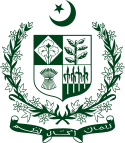1977 Pakistani general election
| |||||||||||||||||||
200 of the 216 seats in the National Assembly 101 seats needed for a majority | |||||||||||||||||||
|---|---|---|---|---|---|---|---|---|---|---|---|---|---|---|---|---|---|---|---|
| |||||||||||||||||||
 Results by constituency | |||||||||||||||||||
| |||||||||||||||||||
| ||
|---|---|---|
Elections
President of Pakistan
Biography Gallery: Picture, Sound, Video |
||
 |
|---|
|
|
General elections were held in
Although the elections were initially scheduled to be held in the second half of 1977 after the completion of the National Assembly's parliamentary term, the
The result was a landslide victory for the PPP, which won 155 seats. Meanwhile, the PNA won only 36 seats; the
Campaign
The elections were held earlier than originally planned, and were expected to be held in the second half of 1977.[4] However, on 7 January 1977, Bhutto appeared on national television, announcing the elections would be held earlier, and started his political campaign shortly after appearing on national television.[4] On 10 January, Election Commissioner of Pakistan Justice Sajjad Ahmad Jan announced the election schedule and declared 19 and 22 January as the last date for receipt of nominations for the Parliament and Provincial Assemblies, respectively.[4]
Bhutto responded aggressively, immediately issuing party tickets to his workers. Unlike the 1970 elections, when
The
Electoral preparations
The Election Commission entered the registry of 30,899,052 voters, commissioned two hundred and fifty five Returning officers (RO) to manage voting system of the polling offices established in entire country. Surprisingly, the elections resulted the supermajority of Pakistan Peoples Party and Zulfikar Ali Bhutto, securing 155 seats out of 200
The result was a victory for the
Results
On 7 March 1977, the Election Commission announced the result in which
Overall, the PPP won 60% of votes, a supermajority in the parliament, voting figures showing the success of the PPP candidates often surpassed the actual number that turned up for voting.[citation needed] In numerous constituencies in Punjab, where Bhutto faced the strongest opposition, Bhutto's candidates returned with over 95% of the vote.[citation needed] Observers noticed that in polling offices where PNA's candidates were strong, the polling was alleged to have been blocked for hours.[citation needed] Observers, both in national and international, quickly pointed out that the results in key constituencies were issued directly from the Prime Minister's office.[citation needed]
| Party | Votes | % | Seats | |||||
|---|---|---|---|---|---|---|---|---|
| General | Women | Minority | Total | +/– | ||||
Pakistan Peoples Party | 10,093,868 | 59.74 | 155 | 10 | 6 | 171 | +85 | |
| Pakistan National Alliance | 6,154,921 | 36.43 | 36 | 0 | 0 | 36 | +24 | |
| Pakistan Muslim League (Qayyum) | 157,370 | 0.93 | 1 | 0 | 0 | 1 | –8 | |
| Pakistan Pakhtunkhwa National Awami Party | 48,145 | 0.28 | 0 | 0 | 0 | 0 | New | |
| Jamiat Ulema-e-Islam (Hazarvi) | 7,595 | 0.04 | 0 | 0 | 0 | 0 | New | |
| Pakistan Inqlabi Mahaz | 6,494 | 0.04 | 0 | 0 | 0 | 0 | New | |
| Tahafuz-e-Islam | 5,206 | 0.03 | 0 | 0 | 0 | 0 | New | |
| Pakistan Worker's Party | 1,716 | 0.01 | 0 | 0 | 0 | 0 | New | |
| Pakistan Socialist Party | 1,060 | 0.01 | 0 | 0 | 0 | 0 | New | |
| Jammaat-e-Aalia Mujahideen | 808 | 0.00 | 0 | 0 | 0 | 0 | New | |
| Independents | 417,808 | 2.47 | 8 | 0 | 0 | 8 | –8 | |
| Total | 16,894,991 | 100.00 | 200 | 10 | 6 | 216 | –97 | |
| Source: Gallup Pakistan, FAFEN | ||||||||
Aftermath
When the results were announced, a great ire on Bhutto was raised by Alliance's leader
Bhutto used repression to curb the Alliance but soon came to conclusion that it was not possible. Therefore, Bhutto tried to use the option of dialogue by holding talks with the Alliance leaders. The Alliance demanded the 50% representation in the government, release of their party workers and leaders, and demanded new elections before 14 August. On 3 July 1977, then-director general of
References
- ISBN 0-19-924958-X
- ^ Bhutto and the 1977 coup The News, 9 July 2017
- ^ General Elections 1977 Story of Pakistan
- ^ a b c d e f g h i Story of Pakistan (June 2003). "General Elections 1977". January 1, 1977. Story of Pakistan, 1977 elections. Retrieved 10 March 2012.
- ISBN 9780312216061.
The reality seems to be that a certain PPP victory was inflated by malpractice committed by local officials, which may have affected 30–40 seats.





